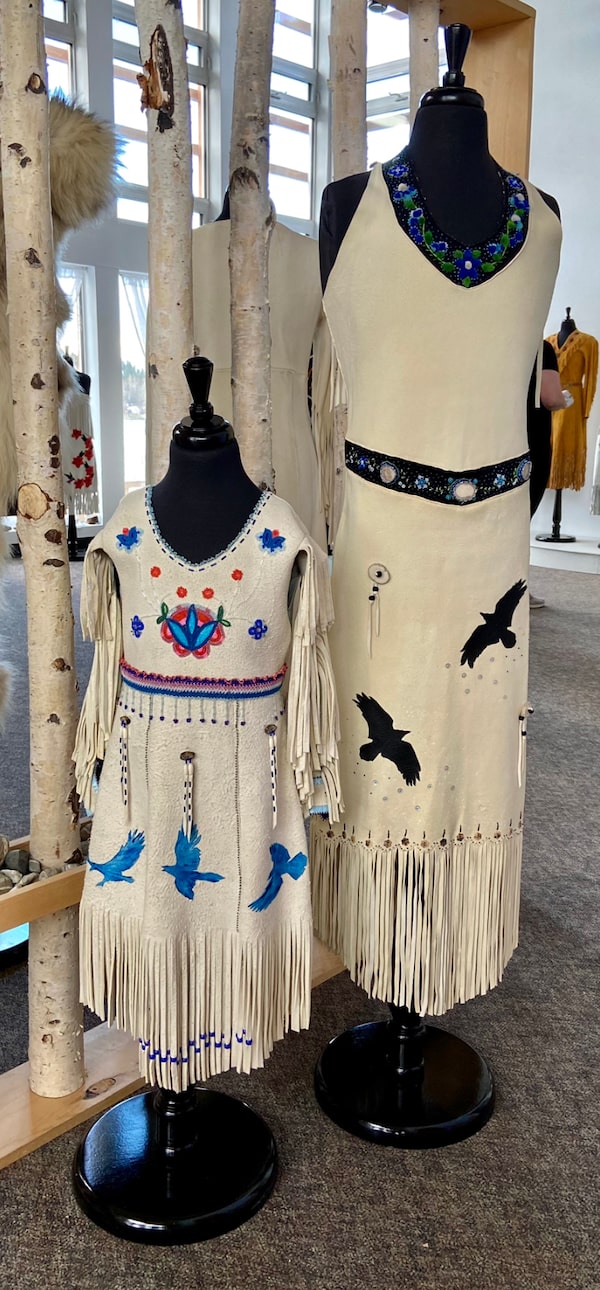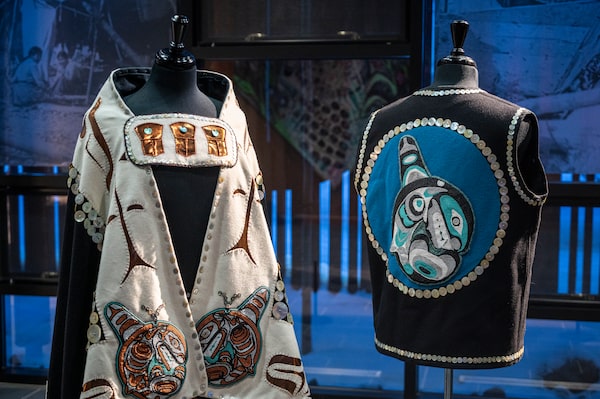Jackie Olson wore a pantsuit to her Yukon First Nations Graduation ceremony. It was 1982 and Olson, who is of Gwich’in and Danish descent, knew very little beforehand about the event, which brings Indigenous high school graduates from across the Yukon (and beyond) to Whitehorse to mark their achievements.
Grads Tiffany Taylor and Kalilah Olson, both wearing dresses by Jackie Olson.Jackie Olson/Handout
Since then, Native Grad – as it is colloquially called – has grown into a landmark event, with more than 100 grads each year – and, before COVID-19, hundreds of friends and family in the audience to cheer them on. “It’s full on,” is how Lisa Dewhurst, a member of the Nlaka’pamuk Nation, describes it. The grads are drummed and danced in. They receive their certificates from the Grand Chief, with all the other Chiefs present. There are gifts, awards. A traditional celebratory meal. The event was cancelled last year but this year’s event, with COVID protocols, went ahead Friday afternoon.
And there is regalia. The days of showing up in an off-the-rack pantsuit are over. The grads wear dresses, vests, moccasins and other pieces created for the occasion, often by family members, who spend months working with deer and moose hide, rabbit fur, beads, abalone buttons, Melton cloth and other traditional materials.
When it was time to plan for her daughter Kalilah’s 2017 graduation, Olson knew they would collaborate to make something special. “We talked about it, we dreamed about it for a while,” she says.
The result – a white Gwich’in style deer-hide dress with black crushed velvet accents, beading around the waist and neckline and caribou tufting on the collar – is part of an exhibition, Honouring Our Future: Yukon First Nation Graduation Regalia currently touring the Yukon.

Kalilah’s grad dress, as well as the one her mom made for her pre-school graduation, was chosen for The Honouring Our Future: Yukon First Nations Graduation Regalia, an exhibition at the Kwanlin Dün Cultural Centre in Whitehorse.Jackie Olson/Handout
The show is the brainchild of Dewhurst, who had a thought a few years back when she was working at the Teslin Tlingit Heritage Centre: Wouldn’t it be wonderful if this elaborate regalia had a little longer in the spotlight? “I felt that these pieces deserved to be highlighted for more than one day,” says Dewhurst, who was born in Merritt, B.C., but has been based in Teslin, Yukon for more than 30 years and has been adopted into the Kukhittan Clan and gifted the name Keis’ex.
The Yukon First Nations Graduation has been held since 1975, in addition to the high school cap-and-gown ceremonies at the students’ schools. Sponsored by the Council of Yukon First Nations and all Yukon First Nations, the event has grown in size and the regalia have become a key part of the event – “a beautiful blend of tradition and high fashion,” as Dewhurst puts it in her curatorial statement.
“I really wanted to honour all of those sewers and mums and aunties and grannies that sit at home all year working on these pieces and sometimes they don’t even make it to grad because they’re far away,” Dewhurst said in an interview.
“They’ve been made on kitchen tables and by working moms who probably worked full-time during the time and sewed until two in the morning to get these pieces done. It’s pure pride and representing their own First Nation, their people. There’s no stamping it out.”
In early 2020, a callout for pieces was made across the Yukon. The exhibition opened in Whitehorse last January. It is travelling to cultural centres across the territory through September, 2023. It is scheduled to open next week at the Dänojä Zho Cultural Centre in Dawson City. Olson, who lives there, was able to visit ahead of the opening.
“It’s like flowing through a crowd of graduates,” she says. “It’s really powerful.”
Olson has three dresses in the show, with a special fourth added for the Dawson City stop.
Long before high school, Kalilah attended the Aboriginal Head Start preschool program. For her Head Start graduation, her mother thought: “I’m going to make her the most beautiful dress in the whole world; she’s going to be my princess.” She worked on it for about a year.
The small, white elk-hide dress with caribou buttons, fringe and blue ravens appliqued across the front, is exhibited right next to the piece Olson made for Kalilah’s Native Grad. The grown-up dress echoes the preschool grad regalia in many ways – white hide, the fringe, black ravens instead of blue, caribou buttons around the waist. The dress tapers to a point, in the Gwich’in style.
Dewhurst also has a piece in the show, a dress she made for her daughter’s Native Grad. Her daughter had ordered a basic dress online. “Then she just handed it to me and said ‘Mum, make it look native.’” Dewhurst hand-stitched designs – buttons, feathers – onto the dress for her daughter, who is in the Raven Clan.

Kalilah’s dress, as well as the one her mom made for her preschool graduation, are installed at the Dänojä Zho Cultural Centre in Dawson City for the exhibition Honouring Our Future: Yukon First Nations Graduation Regalia. The exhibition began at the Kwanlin Dün Cultural Centre in Whitehorse earlier this year and will tour Yukon’s communities for the next two years.Mike Thomas/Handout
This exhibition, an important celebration at any time, feels particularly poignant right now. It seems impossible not to look at these works of art marking the achievements of Indigenous graduates and not think about those 215 children in Kamloops, their bodies buried in unmarked graves on the grounds of the former Kamloops Indian Residential School, as reported by the Tk’emlúps te Secwépemc First Nation. Children who never got to live; certainly did not get to graduate high school proudly wearing their traditional regalia.
Dewhurst, whose mother was a Kamloops Indian Residential School survivor, says while she wasn’t thinking about residential schools or Truth and Reconciliation when she conceived of and created the exhibition, she does believe people will now make that connection.
“It’s another layer that can come out of this exhibit: another layer of awareness and another layer of education, and another layer of really telling the story of resilience. Because 100 per cent, that’s what it is. These pieces were made with love, pride and support, and that love, pride and support [have] risen to the top in so many instances in our past. That can’t be quelled. And here we are in the middle of this huge catastrophe … and to me this exhibit is just another shining example of progress and that love, pride and support that we just won’t let die,” says Dewhurst.
“These slivers of light still come through.”
Sign up for The Globe’s arts and lifestyle newsletters for more news, columns and advice in your inbox.
 Marsha Lederman
Marsha Lederman